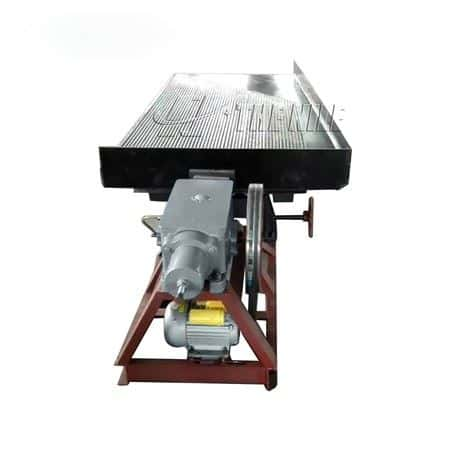

Products
Home > Products > Mineral Processing Equipment > Shaking Table
Processing Materials: Shaking table gravity separator is mainly used to separate mineral raw materials with large specific gravity difference between useful minerals and gangue, such as tungsten, tin ore, and gold ore.

Introduction of Shaking Table Gravity Separator
Shaking table gravity separator, also known as gravity beneficiation shaker. It refers to the mineral separation method that uses the difference in relative density, particle size, and shape of the separated mineral particles and the different movement speed and direction in the medium (water, air, or other liquid with relatively high relative density) to separate them from each other.
Advantages and Discharges of Shaking Table Gravity Separator
1. The production cost of shaking table gravity separator is low.
2. The material size range that can be processed is wide, the coarse material can reach hundreds of millimeters, and the fine material can reach 0.02 mm.
3. It has less environmental pollution, and the product is easy to be dehydrated. But for ore smaller than 0.1mm and coal smaller than 0.5mm, the beneficiation efficiency and equipment processing capacity are both low.

Operating Procedures of Shaking Table Gravity Separator
1.The lateral slope of the shaking table gravity separator must match the size of the lateral water flow to have a good selection effect.
2.The size of flushing water should be appropriate. The flushing water includes feed water and washing water. The distribution of flushing water on the bed surface should be uniform and the size should be appropriate. The grade of concentrate is increased as the large washing water, but the recovery rate is reduced. Generally, washing water should be larger when processing coarse-grained materials or selecting them.
3.The feeding concentration is appropriate. To ensure that the slurry can have sufficient fluidity and stratification along the bed surface of the shaking table gravity separator, and the water depth can submerge the ore particles. In general, the concentration of coarse sand is 20%-30%, and the concentration of fine-grained ore is 15%-25%. Most of the water in the ore feeding flows along the tailings belt, and the fine mud is easy to be washed away, causing the loss of fine-grained metal minerals
4. When the load on the bed increases or the material with a higher density is selected, the larger stroke and stroke should be adopted. The appropriate value of stroke and stroke should be determined by careful examination in practice.
Technical Parameters of Shaking Table Gravity Separator
Model NO. | 6S | Tbele Size | 4520*1850*156mm | |
Stroke | 8-36mm | Motor Power | 1.1kw | |
Time/min | 240-380 | Dimension | 5630*1850*900mm | |
Landscape | 0-5° | Table Weight | 650kg | |
Material | Feeding Size | Mine Density | Flushing Water | Capacity(t/h) |
Coarse Sand | 2-0.5mm | 10-30% | 0.5-3.5t/h | 1-2.5 |
Fine Sand | 0.5-0.074mm | 0.8-1.2 | ||
Ore Mud | 0.0774-0.037mm | 0.3-0.6 | ||